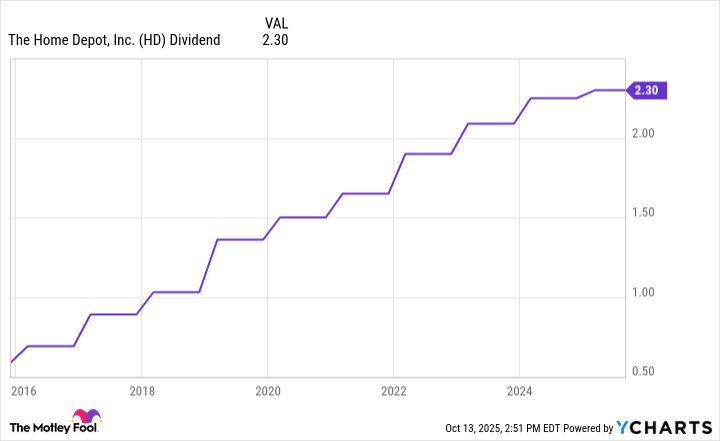Few companies have benefited from the artificial intelligence (AI) revolution quite like Palantir Technologies (PLTR +0.07%). Once simply a niche government contractor, it has evolved into one of the most influential players in enterprise software. Its Artificial Intelligence Platform (AIP) has become a backbone of digital infrastructure for both government agencies and major private enterprises.
Over the past three years, shares of the data-mining specialist have soared by more than 2,000%, lifting its market capitalization above $400 billion -- larger than Salesforce, Adobe, and SAP.
Yet history shows that such periods of parabolic growth must eventually end. Over the next five years, I think two very different companies could quietly surpass Palantir in market cap: One is a retail powerhouse positioned to benefit from a rebound in housing and infrastructure spending, while the other is a semiconductor innovator vying to produce the next generation of AI accelerators.
Home Depot could ride the next wave of economic expansion
If Palantir represents the digital foundation of AI, Home Depot (HD +0.69%) embodies its physical layer. After several years of tight monetary policy and a shift back toward historically normal interest rates, housing affordability has fallen to its lowest levels in decades. However, interest rates are expected to gradually decline from here, which could unleash a wave of pent-up demand for homes, and an associated surge in spending on renovations and home improvement projects. Home Depot's scale and digital supply chain investments, as well as the brand loyalty it inspires, provide it with durable competitive advantages that should work to its benefit as the cycle turns.
However, it also is positioned to capitalize on a less obvious catalyst: $7 trillion worth of AI infrastructure build-outs. Massive data center investments like the Stargate Project are fueling a surge in industrial and commercial construction. From electrical systems and HVAC installations to specialized materials and skilled labor, Home Depot sits squarely at the intersection of these forces.
Home Depot's unique exposure to both residential and commercial development makes it a stealth infrastructure play. Between its potential for share price gains and its consistent dividend growth, the company stands out as a potential long-term compounder of shareholder value. Its valuation could meaningfully expand in the years ahead.
HD Dividend data by YCharts.
AMD is emerging as the biggest rival to Nvidia
Throughout the AI revolution, Advanced Micro Devices (AMD +0.07%) has often been cast as Nvidia's understudy. That perception, however, is beginning to shift.
Major cloud hyperscalers such as Microsoft and Oracle, as well as tech titans like Meta Platforms and OpenAI, are increasingly adding AMD's MI300 and MI400 graphics processing units (GPUs) to their data centers to reduce their dependence on Nvidia's ecosystem. As AI training and inference workloads grow more complex, these companies are rapidly developing multiplatform architectures to enhance flexibility and mitigate supply chain risk.

NASDAQ: AMD
Key Data Points
This strategic diversification not only helps them reduce operational bottlenecks and the pricing pressure they face from Nvidia, but it also positions AMD as a critical enabler in the next wave of AI infrastructure construction.

Image source: AMD.
Innovation comes in many forms
Palantir's rise remains a fascinating chapter within the broader AI narrative, but its valuation may be approaching a peak. Over the next five years, the biggest rewards should go to investors willing to look beyond the usual suspects and identify where the real picks and shovels of economic activity are being sold.
Home Depot stands to benefit from renewed industrial spending and increased homebuilding. Meanwhile, AMD has positioned itself as an indispensable provider of AI computing hardware, steadily raising the stakes with Nvidia amid insatiable demand from hyperscalers for high-end processors.
While Palantir has built an impressive empire connecting software intelligence and data-driven insights, history tends to favor the companies that construct long-lasting frameworks supporting broader innovative cycles. That's why Home Depot and AMD could both be worth more than Palantir by 2030.








